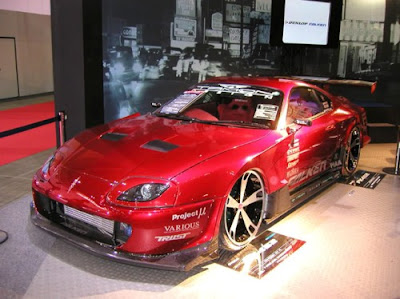

The big news here is without doubt, the EVO X’s all-new 6speed dual-clutch automated manual transmission, or to put it simply, Mitsubishi’s version of Audi-VW’s renowned clutchless DSG gearbox that bears the name “SST”. If you’ve driven an Audi or a VW with this kind of gearbox, you’ll know what we’re talking about, if not, an automated manual transmission allows drivers to choose between fully automated and manual gearbox changes.
Difference is that, compared to semi-automatic transmissions, dual-clutch gearboxes permit drivers of all abilities to shift rapidly through the gears (without the use of a clutch of course) faster than any manual gearbox. To be honest though, it does take out all the fun and personally, I prefer the engaging mechanical feel that you get out of a classic manual gearbox. But anyway, like other dual-clutch transmissions, Mitsubishi’s SST lets the driver to switch between three shifting programs -
As for the Lancer EVO X’s revised vehicle-dynamic system dubbed S-AWC, the difference is the addition of an ASC (Active Stability Control) feature to the ACD (Active Center Differential), AYC (Active Yaw Control) and Sport ABS (Sport Antilock Brake System) which permits the system to control each wheel under a wide range of driving conditions. -Detailed press release and images after the jump
PRESS RELEASE
Mitsubishi Motors Develops S-AWC Vehicle Dynamics Control System & Twin Clutch SST Automated Manual Transmission
July 10, 2007 – Tokyo: Mitsubishi Motors Corporation has developed two new component systems that are expected to feature in the new Lancer Evolution, due to be launched this autumn. S-AWC (Super All Wheel Control) is an advanced vehicle dynamics control system that regulates drive torque at each wheel. Twin Clutch SST (Sport Shift Transmission) is an automated manual transmission that delivers slicker shifting through the gears while freeing the driver from the need to operate the clutch.
In line with its corporate philosophy, Mitsubishi Motors strives to deliver a dynamic driving experience while making advances to keep drivers safe. Twin Clutch SST and S-AWC do so by making driving more intuitive. Both the systems work to efficiently distribute power appropriate to road conditions, and deliver outstanding control and stability maintained by an "intelligent" system that reads and reflects driver intent in real time.
S-AWC:
The system now adds an ASC*1 (Active Stability Control) feature to the ACD*2 (Active Center Differential), AYC*3 (Active Yaw Control) and Sport ABS*4 (Sport Antilock Brake System) components that have proven themselves in the Lancer Evolution series. Integrated system management of these four components allows regulation of torque and braking force at each wheel. S-AWC also now employs yaw rate feedback control. This allows the system to control each wheel under a wide range of driving conditions, thus realizing vehicle behavior that faithfully reflects driver inputs and allows drivers of all abilities to enjoy sporty motoring with confidence.
Twin Clutch SST:
MMC's new automated manual transmission employs dual clutches to realize power transmission efficiencies on a par with a normal manual gearbox while also allowing slick and swift shifting. Allowing drivers of all abilities to shift rapidly up and down through the gears, Twin Clutch SST delivers satisfying acceleration while also returning superior fuel mileage thanks to its high-efficiency power transmission mechanism. The new transmission also features three operating modes tailored to different situations: from around-town drivability to instant-response and follow-the-line sporty motoring on the open road.


1.S-AWC (Super All Wheel Control)
System overview
The S-AWC vehicle dynamics control system integrates management of all its AYC, ACD, ASC and Sport ABS components (see below) while adding braking force control to Mitsubishi Motors' own AYC system. As a result S-AWC elevates drive power, cornering performance as well as vehicle stability under all driving situations, from everyday motoring to emergency evasion maneuvers.
ACD (
The Active Center Differential incorporates an electronically-controlled hydraulic multi-plate clutch. The system optimizes clutch cover clamp load for different driving conditions, regulating the differential limiting action between free and locked states to optimize front/rear wheel torque split and thereby producing the best balance between traction and steering response.
AYC (Active Yaw Control)
AYC uses a torque transfer mechanism in the rear differential to control rear wheel torque differential for different driving conditions and so limit the yaw moment that acts on the vehicle body and enhance cornering performance. AYC also acts like a limited slip differential by suppressing rear wheel slip to improve traction. The first component of its type, AYC was first used in the Lancer Evolution IV launched in April 1996. It then took an evolutionary step forward in the Lancer Evolution VIII launched in January 2003 as the Super AYC when it switched from the use of a bevel gear to a planetary gear differential, thereby doubling the amount of torque it was able to transfer. In comparison to the system used in the Lancer Evolution IX, AYC now features yaw rate feedback control using a yaw rate sensor and also gains braking force control. Accurately determining the cornering dynamics on a real-time basis, the system operates to control vehicle behavior through corners and realize vehicle behavior that more closely mirrors driver intent.
ASC (Active Stability Control)
The ASC system stabilizes vehicle attitude while maintaining optimum traction by regulating engine power and the braking force at each wheel. Taking a step beyond the previous generation Lancer Evolution, the fitting of a brake pressure sensor at each wheel allows more precise and positive control of braking force. ASC improves traction under acceleration by preventing the driving wheels from spinning on slippery surfaces. It also elevates vehicle stability by suppressing skidding in an emergency evasive maneuver or the result of other sudden steering inputs.
Sport ABS (Sport Anti-lock Braking System)
ABS allows the driver to maintain steering control and keeps the vehicle stable by preventing the wheels from locking under heavy braking or when braking on slippery surfaces. The addition of yaw rate sensors and brake pressure sensors to the Sport ABS system has improved braking performance through corners compared to the Lancer Evolution IX.
S-AWC control system
The use of engine torque and brake pressure information in the regulation of the ACD and AYC components allows the S-AWC system to determine more quickly whether the vehicle is accelerating or decelerating. S-AWC also employs yaw rate feedback for the first time. The system helps the driver follow his chosen line more closely by comparing how the car is running, as determined from data from the yaw rate sensors, and how the driver wants it to behave, as determined from steering inputs, and operates accordingly to correct any divergence. The addition of braking force regulation to AYC's main role of transferring torque
between the right and left wheels allows S-AWC to exert more control over vehicle behavior in on-the-limit driving situations. Increasing braking force on the inside wheel during understeer and on the outer wheel during oversteer situations, AYC's new braking force control feature works in concert with torque transfer regulation to realize higher levels of cornering performance and vehicle stability.
Using integrated management of the ASC and ABS systems allows S-AWC to effectively and seamlessly control vehicle dynamics when accelerating, decelerating or cornering under all driving conditions. S-AWC offers three operating modes: TARMAC for dry, paved surfaces; GRAVEL for wet or unmade surfaces, and SNOW for snow covered surfaces. When the driver selects the mode best suited to current road surface conditions S-AWC operates to control vehicle behavior accordingly and allow the driver to extract the maximum dynamic performance from his vehicle.


2.Twin Clutch SST (Sport Shift Transmission)
The mechanism
Twin Clutch SST puts odd (1st, 3rd, 5th) and even (2nd, 4th and 6th) gears on separate input shafts, each connected to an individual clutch. With both clutches under precise system control, this arrangement allows lightening-fast, smooth and lag-free gear changes with no interruption in power delivery. Using clutches instead of a torque converter to transmit power makes the Twin Clutch SST simpler in structure and reduces power transmission losses for higher transmission efficiency that leads to improved fuel mileage.
Drive modes
Twin Clutch SST allows the driver to switch between three shifting programs -
a. Normal mode
For use around town and other normal driving situations,
b. Sport mode
For use when driving in the mountains or when engine braking is required, Sport mode scheduling uses higher shift points and quicker shifting to deliver instant throttle response that instills in the driver a closer man/machine relationship.
c. S-Sport mode
Compared with Sport mode, S-Sport mode scheduling keeps the engine turning at higher revs while allowing lightening-fast shifting.


















